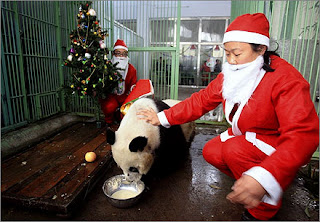Merry Christmas Ape Man
In 2002, I visited a site near Datong 大同 in Shanxi 山西 Province where archaic Homo sapiens bones had been discovered. The cave and the casts of bones were not especially interesting, and the all I really remember from the visit was the English sign advertising China’s “ape man” outside and ascending into the cave’s main chamber to see colored lights arranged to spell, “Merry Christmas” in English. This was April, in a nation with few Christians, in the home of the ape-man. Not to be a scrooge, but what the humbug does any of this have to do with Christmas?
Each year, many Americans decry the rampant consumerism that has come to typify Christmas celebrations. However, its manifestation as a secular, market-driven excuse to buy stuff has helped Christmas become a global holiday. Despite the fact that only one or two percent of China’s population is Christian, Christmas decorations, music, and, of course, sales, are ubiquitous in all of its major cities. Has producing millions of glowing reindeer, plastic snow men, and artificial pine trees finally gotten to the Chinese people or is this just a natural outgrowth of China’s embrace of global capitalism?
It appears that Christmas first entered China through hotels (including many Western chains) that cater to Western tourists with holiday decorations and traditional Christmas dinners. Then, department stores hoping to extend the holiday shopping season to Asia adopted Yuletide regalia as well. Indeed, it seems the number and general shininess of decorations is redoubled in China due to a general affinity for all things that flash, sparkle, or jingle; See pictures of the splendiferous tackiness of it all here.
Speaking of excess, China is now home to the world’s largest snow sculpture of Santa Claus 聖誕老人 at 56 feet tall and over 260 feet wide in Jingyuetan National Forest Park 净月潭国家森林公园 in Changchun 長春, capital of Jilin 吉林 Province, see pictures here. The writers over there at Danwei note that since few in China know the “true meaning of Christmas” anyway, there’s no ridiculous hubbub over the proper season’s greeting or religious displays on public land. Indeed, there is no “Christ” in the Chinese word; 聖誕節 translates to the more ambiguous, “saint’s birthday.”
While it is definitely not discouraged, Christmas is not an official state holiday, and many rural residents only know of it from Hollywood movies. Since people have to work on Christmas day, any celebrations generally take place on Christmas Eve, with young people hitting clubs and restaurants and others flocking to malls and shopping districts to take in the holiday cheer. And, like any Chinese holiday, it’s mostly about eating lots of good food.
In a 2007 article called, “A Chinese Christmas Story “ Gary Sigley argues that Christmas has evolved as a sort of counterweight to the traditional big holiday of the year, Chinese New Year. While the latter is focused on familial obligations and Chinese tradition, the former has become about young people, modernity, cosmopolitanism, and partying with friends. But this dichotomy makes the association of Christmas with an “ape man” excavation even more confusing. As an archeological site, perhaps it is associated with Western science, and Western tourists just love Christmas (even in April?). But as humans, we are all attracted to shiny objects, and maybe Christmas is just a great excuse to put shiny things everywhere while telling ourselves we’re cool, cosmopolitan, religious, or just doing our part to stimulate the economy.
Further reading: Sigley, Gary. 2007. A Chinese Christmas Story. In Discourse as Cultural Struggle ed. Shi-xu. Hong Kong: Hong Kong University Press



Comments
Post a Comment